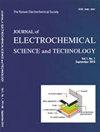Electro-Oxidation in Combination with Biological Processes for Removal of Persistent Pollutants in Wastewater: A Review
IF 3
4区 工程技术
Q3 ELECTROCHEMISTRY
Journal of electrochemical science and technology
Pub Date : 2021-11-02
DOI:10.33961/jecst.2020.01746
引用次数: 3
Abstract
Persistent organic pollutants (POPs) and emerging pollutants (EP) are characterized by their difficulty to be removed through biological oxidation processes (BOPs); they persist in the environment and could have adverse effects on the aquatic ecosystem and human health. The electro-oxidation (EO) process has been successfully used as an alternative technique to oxidize many kinds of the aforementioned pollutants in wastewater. However, the EO process has been criticized for its high energy consumption cost and its potential generation of by-products. In order to decrease these drawbacks, its combination with biological oxidation processes has been reported as a solution to reduce costs and to reach high rates of recalcitrant pollutants removal from wastewaters. Thus, the location of EO in the treatment line is an important decision to make, since this decision affects the formation of by-products and biodegradability enhancement. This paper reviews the advantages and disadvantages of EO as a pre and post-treatment in combination with BOPs. A perspective of the EO scaleup is also presented, where hydrodynamics and the relationship of A/V (area of the electrode/working volume of the electrochemical cell) experiments are examined and discussed.电氧化与生物工艺相结合去除废水中持久性污染物的研究进展
持久性有机污染物(POPs)和新兴污染物(EP)的特点是难以通过生物氧化过程(BOPs)去除;它们在环境中持续存在,可能对水生生态系统和人类健康产生不利影响。电氧化(EO)工艺已成功地作为一种替代技术来氧化废水中的多种上述污染物。然而,EO工艺因其高能耗成本和可能产生的副产品而受到批评。为了减少这些缺点,它与生物氧化过程的结合已经被报道为一种降低成本和达到废水中顽固污染物去除率的解决方案。因此,EO在处理线上的位置是一个重要的决策,因为这个决策影响副产物的形成和生物降解性的增强。本文综述了EO结合防喷器作为前处理和后处理的优缺点。本文还介绍了电化学放大的前景,其中流体力学和A/V(电极面积/电化学电池的工作体积)实验的关系进行了检查和讨论。
本文章由计算机程序翻译,如有差异,请以英文原文为准。
求助全文
约1分钟内获得全文
求助全文
来源期刊

Journal of electrochemical science and technology
ELECTROCHEMISTRY-
CiteScore
6.30
自引率
8.10%
发文量
44
期刊介绍:
Covering fields:
- Batteries and Energy Storage
- Biological Electrochemistry
- Corrosion Science and Technology
- Electroanalytical Chemistry and Sensor Technology
- Electrocatalysis
- Electrochemical Capacitors & Supercapcitors
- Electrochemical Engineering
- Electrodeposition and Surface Treatment
- Environmental Science and Technology
- Fuel Cells
- Material Electrochemistry
- Molecular Electrochemistry and Organic Electrochemistry
- Physical Electrochemistry
- Solar Energy Conversion and Photoelectrochemistry
 求助内容:
求助内容: 应助结果提醒方式:
应助结果提醒方式:


